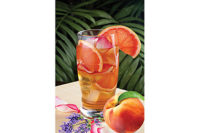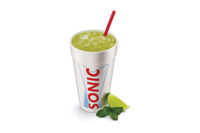Nondairy beverages trends include functional flavors, fruit and veggie flavors

Cooling flavors like mint support the refreshing experience of a beverage, Robertet Flavors’ David Wasnak said. (Image courtesy of The Coca-Cola Co.)

Ginger offers a complex, sweet-and-spicy flavor that pairs well with other flavors, notes Robertet Flavors’ David Wasnak. (Image courtesy of Reed’s Inc.)


In contrast with last year’s indulgent flavor trends, beverages this year are shifting to reflect consumer interest in health and wellness.
“We have noticed the beverage market is leaning more toward the ongoing flavor trends of superfruits, exotic fruits, tropical fruits and fruit-and-vegetable combinations in both non-alcoholic and alcoholic beverages,” said Alex Scott, flavorist at Gold Coast Ingredients Inc., Commerce, Calif. “As growing numbers of consumers are becoming more health conscious, beverage companies are targeting these niche markets with flavors that reflect high nutritional value and more health benefits.”
This is especially true for vegetable-based flavors, points out Douglas Rash, group vice president of global sales at Treatt USA, a Lakeland, Fla.-based division of Treatt plc. “The perception of such concepts is positive in that vegetables are seen as imparting health,” he explained. “With 55% of people globally making a conscious effort to eat as many vegetables as possible, the so-called ‘healthy halo’ of vegetable-based beverages makes them a hit with all types of consumers. The trend is now spreading across nearly all beverage sectors.”
Treatt offers a variety of vegetable flavors, including green bell pepper, roasted bell pepper, tomato, jalapeño and cucumber. The benefits of each flavor depend on the type of beverage, Rash said. For example, jalapeño is particularly suited to alcohol beverages, as it imparts the earthy, green impact of the peppers without the heat, he explained. Cucumber, on the other hand, is applicable in a wider variety of beverages and can be used to deliver a subtle, fresh green note or a stronger cucumber flavor, depending on the usage level, he said.
In line with these consumer interests in vegetable flavors, Innova Market Insights, the Netherlands, confirmed that vegetable flavors are showing more prominence in the beverage market, frequently in combination with fruit flavors in juices, smoothies and teas. In fact, the number of beverage launches featuring celery flavor rose six-fold in 2012, and the amount of new beverages featuring cucumber and beet flavor doubled that year, the market research firm reported. Vegetable flavors add health-giving phytochemicals to beverages as well as a new flavor element, it explained.
These flavors that were once thought of as strictly for savory flavor palates have been especially relevant in juice blends and enhanced waters, said Cathianne Leonardi, senior flavorist at Allen Flavors Inc., Edison, N.J. Products like Camden, N.J.-based Campbell Soup Co.’s V8 V-Fusion Juice line, which marries vegetable and fruit juices, and San Francisco-based Hint Inc.’s cucumber-flavored enhanced water variety have helped to promote these types of flavors in the consumer market, she cited as examples.
Between August 2013 and August 2014, total new U.S. beverage launches with vegetable flavors, including fruit-and-vegetable combinations, numbered 114, compared with 94 products in the 2012-2013 period, according to the Mintel Global New Products Database. This includes juices and juice drinks, enhanced waters, beers, spirits, drink mixes, sports drinks, coffees, teas and carbonated soft drinks.
Picking fruit
On the fruit side, consumers are interested in true-to-fruit fresh tastes from well-known domestic fruits, including blueberries, raspberries, cranberries, pomegranates and blackberries, according to Anton Angelich, group vice president of marketing at Virginia Dare, Brooklyn, N.Y.
To add a sophisticated twist to these familiar flavors, consumers are calling for specific varietals of fruit flavors, Angelich said. “An apple-flavored beverage is not just apple anymore; it is becoming more and more a thing about which variety it represents,” he explained.
To meet this need, California Custom Fruits and Flavors Inc., Irwindale, Calif., offers a Sweet Fiji type apple flavor for use in product applications.
In addition to including them in flavor formulations, beverage-makers also should call out specific fruit varietals on beverage labels, as that has proven to be a major selling point, said Jim Hamernik, director of research and development at Downers Grove, Ill.-based Flavorchem Corp.
“Consumers are looking for more than just a lemon flavor,” he explained. “To declare something like a Meyer lemon on a label can increase interest in a product.”
Sweet and spicy
Another twist on a beverage market trend is the growing sweet-and-spicy trend, evolving from the hot-and-spicy trend. Judson McLester, executive chef and ingredient sales manager for Tabasco at McIlhenny Co., Avery Island, La., said this flavor segment has shown the most growth and ingenuity recently compared with other types of flavors. He credits Thai cuisine with leading the trend.
The sweet-and-spicy blend of tastes adds a multisensory experience to the flavor profile, said Bridget Schigoda, consumer insights manager at Sensient Flavors, a Hoffman Estates, Ill.-based subsidiary of Sensient Technologies Corp.
“Sweet-and-spicy flavor combinations are popping up in most beverage categories,” she said.
Some sweet-and-spicy combinations can be a bit milder and more mainstream, Allen Flavors’ Leonardi said. For example, chai tastes in tea can be calm or sweet and spicy; pumpkin pie flavors for coffees, hot chocolates and other beverages offer a seasonal element to this trend, she said.
Ginger, another mainstream ingredient, is growing in popularity in the sweet-and-spicy arena because its innate sweet-and-spicy flavor profile pairs well with other flavors, explained David Wasnak, associate director of marketing and consumer insights at Robertet Flavors, Piscataway, N.J. As consumer interest in spices and herbal and botanical flavors grew, the spice flavor emerged into the consumer packaged goods space through beverages like teas, fresh-pressed juices, kombuchas and hard ciders, he said.
The Wauconda, Ill.-based Synergy Flavors team also noted that it has seen increased requests for ginger. “[Ginger] offers more complexity,” the Synergy Flavors team said. “We’ve cycled through the heat series, and people are looking for more complexity, as [ginger is] spicy and rich.”
The flavor also is popular in combinations, such as mango ginger and ginger cardamom, for use in teas and adult-profile beverages, according to the team. Ginger cardamom is especially trending in whiskeys, teas and chai-based beverages, it noted.
In addition to a sweet-and-spicy flavor profile, ginger often is perceived as a better-for-you product because of its digestive health benefits, Robertet Flavors’ Wasnak said.
Sometimes the functional side of the spicy flavor in the combination helps make it appealing to a wider variety of consumers, said Wasnak. For example, people who do not like spicy flavors might still consume a spicy lemonade juice cleanse drink for the functional benefits, he pointed out.
Gold Coast Ingredients’ Scott said that the spicy kick also plays a functional role in energy drinks.
“[Sweet-and-spicy combinations] are also starting to show up in some energy drink formulations for both physical and psychological effects to give consumers a more intense energy-boosting experience,” he said.
For other consumer groups, including the growing Hispanic and Asian populations in the United States, as well as millennials, the sweet-and-spicy and even just spicy flavor trends should continue to be areas of flavor growth, experts note.
However, the sweet-and-spicy trend can be otherwise limited by consumer taste preferences, Gold Coast Ingredients’ Scott said. Consumers have varying levels of heat sensitivity and tolerances, so that has limited trend growth, he said. In addition, a spicy component alters consumers’ perceptions of a beverage as cool and refreshing, he said.
Robertet Flavors’ Wasnak agrees that sweet-and-spicy products tend to be polarizing, and, therefore, expects them to be more applicable to limited-time or niche products. Instead of the heat, he sees cooling flavors, such as mint, as trending.
“In addition to tea and a few other categories it was established in, we are beginning to see mint and other cooling flavors, such as cucumber, work themselves into a variety of products,” he explained. “Mint is the most noteworthy, now finding its way into trending categories like lemonade.”
A taste for exploration
In order to ensure beverage manufacturers are ahead of trends, flavor suppliers are constantly researching up-and-coming combinations.
In partnership with its SXT Flavors Latin America team, Sensient Flavors identified several sweet-and-spicy combinations, including chili mango, grapefruit cayenne, spicy pear and spicy ginger lime, as flavor combinations that will likely become popular in the coming years. Through its Trends to Taste Program, which identifies flavors that currently are trending and probably will trend in the future, Sensient Flavors also has identified some up-and-coming exotic, regional flavors that fit into consumer interests in ethnic and complex spice flavors.
For this year, Sensient identified ras el hanout and gochujang as popular or soon-to-be popular flavors. Ras el hanout, which means “top of the shelf” in Arabic, is a Moroccan spice blend that consists of the best spices a merchant has to offer, including cardamom, clove, cinnamon, chili peppers, coriander, cumin, peppercorn, paprika, fenugreek and turmeric. In some cases, the blend can include up to 25 different components, Schigoda explained. Gochujang, which has been described as the next sriracha sauce, is a savory and pungent fermented Korean condiment made from red chili, rice, fermented soybeans and salt, according to Sensient Flavors.
Flavor experts also are expecting a proliferation of international and ethnic flavors, particularly from the Middle East, Southeast Asia and the Caribbean, as millennials continue to seek adventurous flavors.
Looking for a reprint of this article?
From high-res PDFs to custom plaques, order your copy today!








